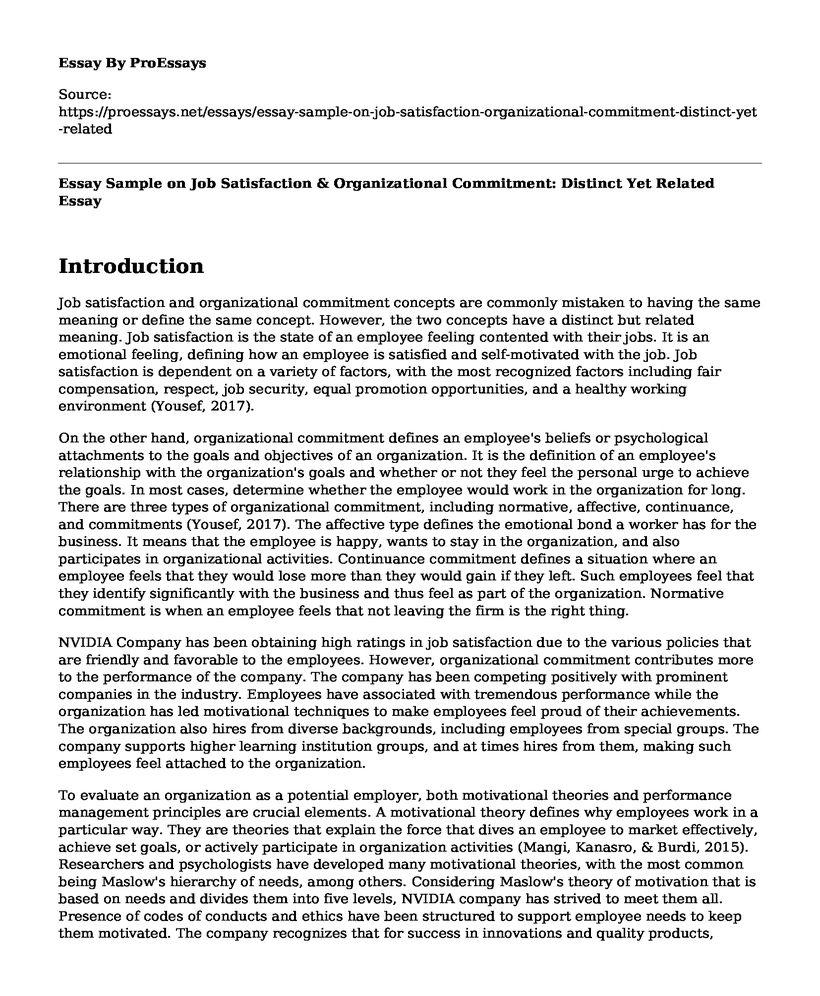Introduction
Job satisfaction and organizational commitment concepts are commonly mistaken to having the same meaning or define the same concept. However, the two concepts have a distinct but related meaning. Job satisfaction is the state of an employee feeling contented with their jobs. It is an emotional feeling, defining how an employee is satisfied and self-motivated with the job. Job satisfaction is dependent on a variety of factors, with the most recognized factors including fair compensation, respect, job security, equal promotion opportunities, and a healthy working environment (Yousef, 2017).
On the other hand, organizational commitment defines an employee's beliefs or psychological attachments to the goals and objectives of an organization. It is the definition of an employee's relationship with the organization's goals and whether or not they feel the personal urge to achieve the goals. In most cases, determine whether the employee would work in the organization for long. There are three types of organizational commitment, including normative, affective, continuance, and commitments (Yousef, 2017). The affective type defines the emotional bond a worker has for the business. It means that the employee is happy, wants to stay in the organization, and also participates in organizational activities. Continuance commitment defines a situation where an employee feels that they would lose more than they would gain if they left. Such employees feel that they identify significantly with the business and thus feel as part of the organization. Normative commitment is when an employee feels that not leaving the firm is the right thing.
NVIDIA Company has been obtaining high ratings in job satisfaction due to the various policies that are friendly and favorable to the employees. However, organizational commitment contributes more to the performance of the company. The company has been competing positively with prominent companies in the industry. Employees have associated with tremendous performance while the organization has led motivational techniques to make employees feel proud of their achievements. The organization also hires from diverse backgrounds, including employees from special groups. The company supports higher learning institution groups, and at times hires from them, making such employees feel attached to the organization.
To evaluate an organization as a potential employer, both motivational theories and performance management principles are crucial elements. A motivational theory defines why employees work in a particular way. They are theories that explain the force that dives an employee to market effectively, achieve set goals, or actively participate in organization activities (Mangi, Kanasro, & Burdi, 2015). Researchers and psychologists have developed many motivational theories, with the most common being Maslow's hierarchy of needs, among others. Considering Maslow's theory of motivation that is based on needs and divides them into five levels, NVIDIA company has strived to meet them all. Presence of codes of conducts and ethics have been structured to support employee needs to keep them motivated. The company recognizes that for success in innovations and quality products, employees play a primary role.
Performance management principles are a wide range of mechanisms used to monitor, collect, and analyze progress to improve employee performance. The aim of these principles is turning organizational goals into departmental and individual goals, to ultimately achieve set objectives (Morden, 2016). Employees are encouraged to be self-managed rather than being controlled, with constant continuous feedbacks, organizational support, and an open leadership style. NVIDIA has invested in some of these principals, through mechanisms such as two-way communication leadership style and departmental/individual projects support. Innovation is highly encouraged through a self-managed support mechanism. NVIDIA is a potential employer, where both job satisfaction and organizational commitment are highly achievable.
References
Mangi, A. A., Kanasro, H. A., & Burdi, M. B. (2015). Motivation tools and organizational success: A criticle analysis of motivational theories. The Government-Annual Research Journal of Political Science., 4(4). Retrieved from http://sujo-old.usindh.edu.pk/index.php/THE-GOVERNMENT/article/view/1607
Morden, T. (2016). Principles of strategic management. Routledge. Retrieved from https://www.taylorfrancis.com/books/9781315602172
Yousef, D. A. (2017). Organizational commitment, job satisfaction and attitudes toward organizational change: A study in the local government. International Journal of Public Administration, 40(1), 77-88. Retrieved from https://www.tandfonline.com/doi/abs/10.1080/01900692.2015.1072217
Cite this page
Essay Sample on Job Satisfaction & Organizational Commitment: Distinct Yet Related. (2023, Jan 28). Retrieved from https://proessays.net/essays/essay-sample-on-job-satisfaction-organizational-commitment-distinct-yet-related
If you are the original author of this essay and no longer wish to have it published on the ProEssays website, please click below to request its removal:
- Gender Discrimination at Workplaces Essay
- Family Life Education Programs Addressing Socioemotional Topic Essay
- Reflection on Employee Selection Paper Example
- Evidence-Based Medicine in Depression Essay Example
- Essay Example on Working at McDonald's: How It Can Impact a Youth's Future
- Essay Example on Positive Effects of Employee Retention: Morale, Productivity, Cost-Effectiveness
- Shadow Experience - Essay Sample







